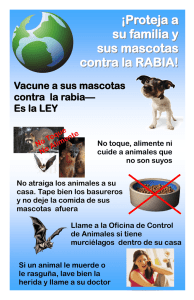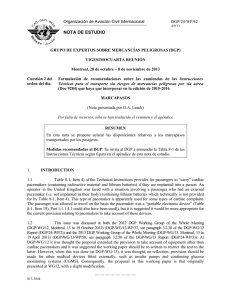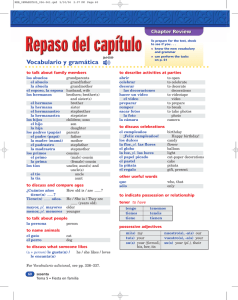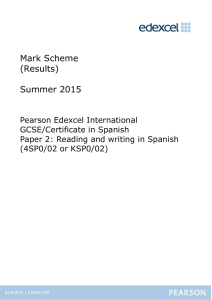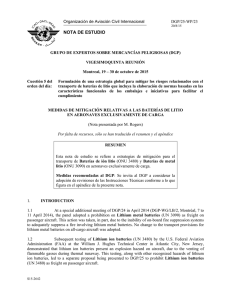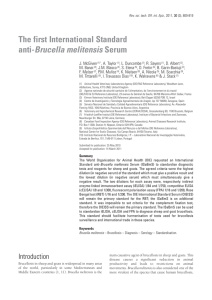nota de estudio
Anuncio
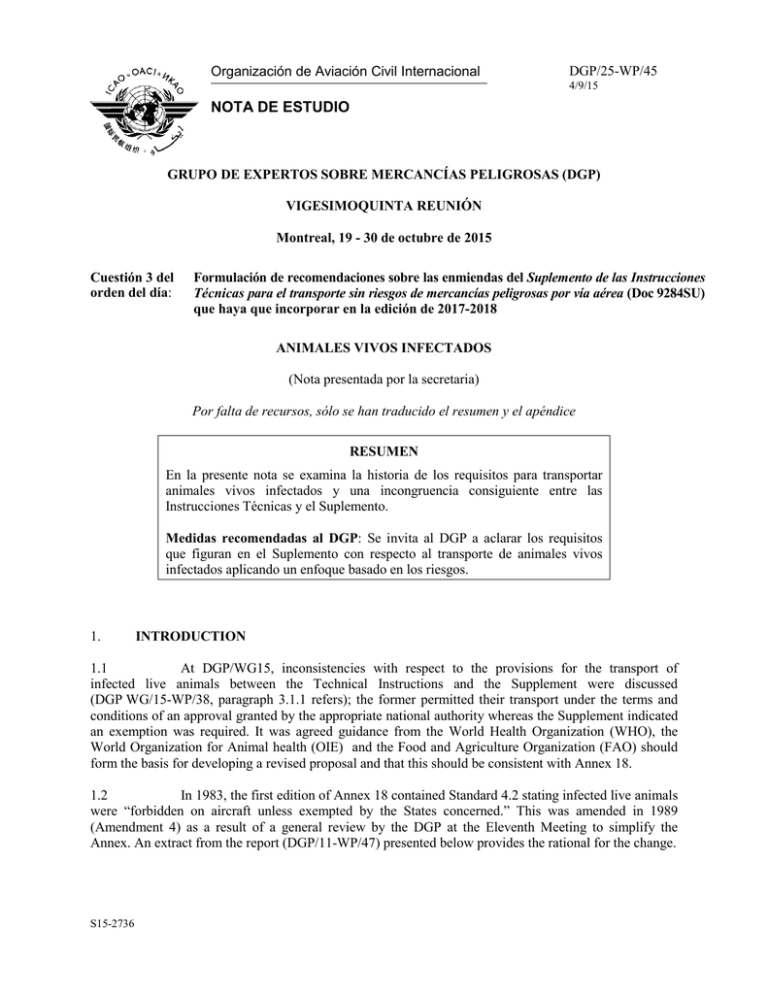
Organización de Aviación Civil Internacional DGP/25-WP/45 4/9/15 NOTA DE ESTUDIO GRUPO DE EXPERTOS SOBRE MERCANCÍAS PELIGROSAS (DGP) VIGESIMOQUINTA REUNIÓN Montreal, 19 - 30 de octubre de 2015 Cuestión 3 del orden del día: Formulación de recomendaciones sobre las enmiendas del Suplemento de las Instrucciones Técnicas para el transporte sin riesgos de mercancías peligrosas por vía aérea (Doc 9284SU) que haya que incorporar en la edición de 2017-2018 ANIMALES VIVOS INFECTADOS (Nota presentada por la secretaria) Por falta de recursos, sólo se han traducido el resumen y el apéndice RESUMEN En la presente nota se examina la historia de los requisitos para transportar animales vivos infectados y una incongruencia consiguiente entre las Instrucciones Técnicas y el Suplemento. Medidas recomendadas al DGP: Se invita al DGP a aclarar los requisitos que figuran en el Suplemento con respecto al transporte de animales vivos infectados aplicando un enfoque basado en los riesgos. 1. INTRODUCTION 1.1 At DGP/WG15, inconsistencies with respect to the provisions for the transport of infected live animals between the Technical Instructions and the Supplement were discussed (DGP WG/15-WP/38, paragraph 3.1.1 refers); the former permitted their transport under the terms and conditions of an approval granted by the appropriate national authority whereas the Supplement indicated an exemption was required. It was agreed guidance from the World Health Organization (WHO), the World Organization for Animal health (OIE) and the Food and Agriculture Organization (FAO) should form the basis for developing a revised proposal and that this should be consistent with Annex 18. 1.2 In 1983, the first edition of Annex 18 contained Standard 4.2 stating infected live animals were “forbidden on aircraft unless exempted by the States concerned.” This was amended in 1989 (Amendment 4) as a result of a general review by the DGP at the Eleventh Meeting to simplify the Annex. An extract from the report (DGP/11-WP/47) presented below provides the rational for the change. S15-2736 DGP/25-WP/45 “2.2.4 Similar problems were identified with Chapter 4 owing to the details included relative to dangerous goods not permitted to be transported. It was considered preferable that the chapter should now make general statements about limitations on the transport of dangerous goods and the detail would be in the Technical Instructions.” 1.3 Specifically, the Standard in 4.2 was modified so that infected live animals were “forbidden on aircraft unless exempted by the States concerned or unless the provisions of the Technical Instructions indicate they may be transported under an approval issued by the State of Origin.” However, the corresponding provision in the Technical Instructions was not changed until the 2005-2006 Edition. This edition incorporated changes from the 13th Revised Edition of the UN Recommendations on the Transport of Dangerous Goods and included major changes to the provisions for infectious substances including the move from the concept of using risk groups for transport classification purposes to that of different categories as well as the development of new packing instructions. In order to align with the UN, a new provision 2:6.3.2.6 was developed: “A live animal that has been intentionally infected and is known or suspected to contain an infectious substance must not be transported by air unless the infectious substance contained cannot be consigned by any other means. Infected animals may only be transported under terms and conditions approved by the appropriate national authority.” 1.4 The corresponding chapter in the Supplement, S-1;2, “Limitation of dangerous goods on aircraft — infected live animals” and dating from 1982 and which refers to exemptions, was not amended accordingly and thus the inconsistency has been created. 1.5 Based on the above explanation for the inconsistency, and noting that the WHO adopted a risk based approach when revising the classification criteria for infectious substances and that the OIE provides guidance on the transport of live animals, it is suggested the Supplement should be revised to take this into account and to clarify the requirements. Depending upon the outcome of the discussion, a consequential amendment may be required for 2;6.3.6.1 of the Technical Instructions. 2. ACTION BY THE DGP 2.1 The DGP is invited to amend Part 1, Chapter 2 of the Supplement as shown in the appendix to this working paper. ———————— DGP/25-WP/45 Apéndice APÉNDICE ENMIENDA PROPUESTA DE LA PARTE S-1 DEL SUPLEMENTO Parte S-1 GENERALIDADES ... Capítulo 2 RESTRICCIÓN DE MERCANCÍAS PELIGROSAS EN LAS AERONAVES — ANIMALES VIVOS INFECTADOS 2.1 La utilización de animales vivos sólo debe considerarse cuando se trate del transporte de alguna una sustancia infecciosa, cuando dicha sustancia no pueda transportarse por ningún otro medio. Los animales infectados sólo pueden transportarse cuando los Estados interesados conceden la correspondiente dispensa conforme a los términos y condiciones de una aprobación otorgada por las autoridades que correspondan de los Estados de origen [tránsito], [destino] y el explotador”. 2.2 Los animales infectados deberán deben transportarse en un embalaje a prueba de gérmenes, que ofrezca tantas garantías como el que se utiliza para el transporte de animales gnotobióticos (libres de gérmenes). Estos envíos deben declararse y etiquetarse de la siguiente manera: “Animal vivo” y “Sustancia infecciosa 2.23 Cuando un recipiente vacío haya de devolverse al expedidor, se deberá desinfectar/esterilizar debidamente antes de transportarlo. Además, deben quitarse, borrarse o hacerse invisibles todas las etiquetas (“Animal vivo” y “Sustancia infecciosa”). (Véase también la Parte S 6;6). Nota. 1.— Al considerar las solicitudes de aprobación en estos casos, debe aplicarse un enfoque basado en los riesgos, teniendo en cuenta si la sustancia infecciosa se clasifica como Categoría A o Categoría B y si se le asigna a ONU 2814 u ONU 2900. Nota 2.— En el Código Sanitario para los Animales Terrestres de la OIE (http://www.oie.int/es/normasinternacionales/codigo-terrestre/acceso-en-linea/) y el Código Sanitario para los animales acuáticos de la OIE (http://www.oie.int/es/normas-internacionales/codigo-acuatico/acceso-en-linea/), se proporciona orientación acerca de las normas internacionales para la exportación/importación de animales vivos. ... — FIN —
